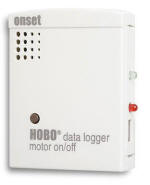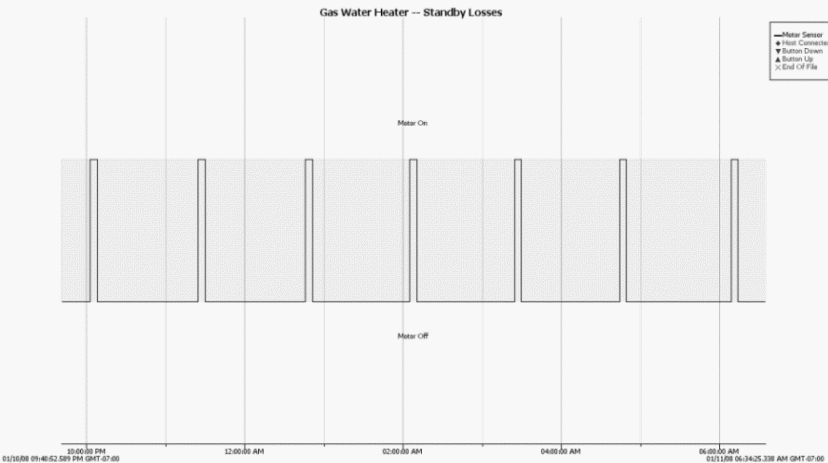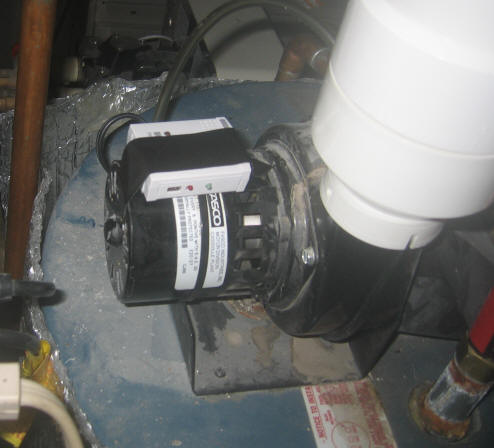
Search
The Renewable Energy site for Do-It-Yourselfers
Monitoring Motor
On Time
|
This small logger monitors the on
time for the motor its attached to.

The monitor is simply
attached to the case of the motor with tape or a magnet -- no wiring
needed. It keeps track of on time by monitoring the magnetic field
of the motor.
This particular motor monitor is from Onset Computer, but I am sure
other brands are available. It costs $79, but the Onset software
that is used to read and plot data from their full logger family is also
required.
Logging the time that an electric motor stays on can be useful for
things like estimating pumping or fan power consumption, and keeping
track of the on and off time pattern under various conditions. |
|
The logger can also be used as a rough way to estimate fuel consumption for
appliances in which a motor is on only during times when the appliance is using
fuel -- for example, a forced air furnace. Some examples below.
An Example: Using the motor monitor to estimate water heater standby losses
My propane water heater uses a power vent fan to push combustion products up
the flue. This fan is basically only on when the burner is on, so
monitoring the motor on time for the power vent gives a good indication of the
burner on time.
The plot below shows the on time for the power vent fan (and roughly the
burner) for our propane gas water heater during the night when no hot water
demands are being made.

The logger provides the on time for
the power vent motor on the water heater. This power vent turns on just
before the burner comes on, and remains on for a few seconds after the burner
goes off.
During the middle of the night, the
plot indicates that the burner comes on about every 1.25 hours for about 5.1
minutes. This is just to offset the heat losses from the tank and keep the
water up to temperature.
The label on the heater states that
the burner uses 40,000 BTU/hr when on.
To estimate the amount of propane
used to just keep the tank water warm:
The power vent motor comes on for
about 5.1 minutes every 1.25 hours.
So, the burner on time is 4.1
minutes per hour.
The total burner on time for
standby losses for a year would be about (4.1 min/hr)(1 hr/60min)(24
Hr/day)(365 day/yr) = 598 hr/yr
The propane use per year is
(598 hr/year)(40000 BTU/hr)(1 gal/92000 BTU) = 260 gal per year.
So, about 260 gallons per year of
propane are used just to offset standby heat losses on our propane gas water
heater. This rather staggering number lead to an investigation of our
very wasteful hot water recirculation system. this recirculation
system results in a waste of nearly 200 gallons or propane a year --
details here
...
When you actually measure things
you always learn something useful, and often learn something surprising!

The motor monitor (small white box) taped to the water heater power vent motor.
Estimating Furnace Fuel Consumption
You can also use it as a rough way to estimate (for example) furnace fuel
consumption by logging the furnace fan on time:
- Log the on time of the furnace fan motor with the logger. Correct
these per the note below.
- Multiple the furnace BTU input rating per hour by the corrected fan on
time to get the total BTU uses over the logged interval.
To correct the furnace fan motor on time to the burner on time:
You want the actual burner on time, which is a
little different than the fan motor on time.
When the furnace starts, the burner runs for a
little while to heat up the heat exchanger before the fan comes on.
Note the time lag from the time the burner comes on until the fan comes on,
and add this time to each of the fan on times.
When the burner shuts down, the fan runs for a
while to remove the heat remaining in the heat exchanger. Note the
time lag from burner shut down to fan shut down, and subtract this from the
fan on times.
Gary Jan 11, 2008, Jan 17, 2008


